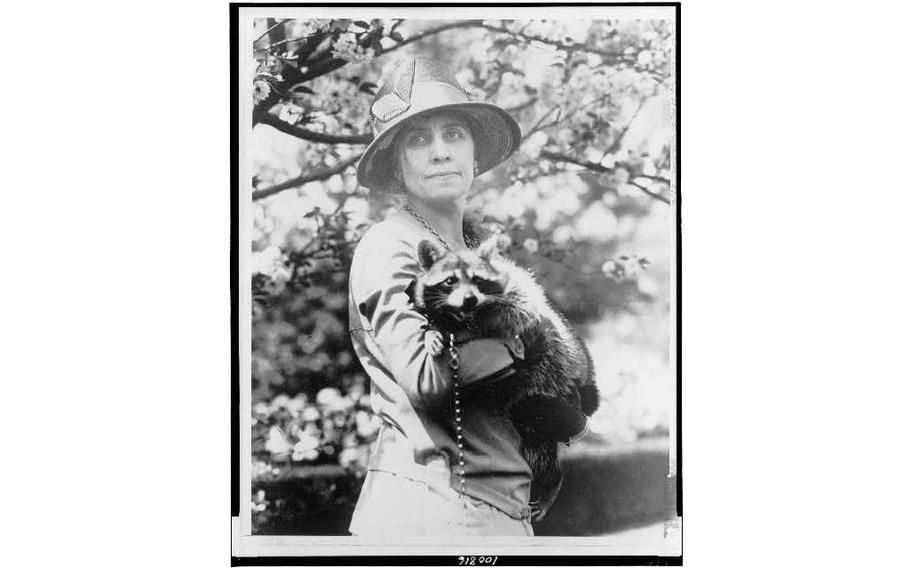On Nov. 19, 1963, a 55-pound broad white tom stood atop his cage in the Rose Garden with a sign around his neck: “GOOD EATING, MR. PRESIDENT!” Standing next to the turkey was President John F. Kennedy.
From the moment Kennedy saw the fated fowl, he decided the first family would not be eating that turkey.
“We’ll just let this one grow,” the president said with a grin, according to news reports from the time.
That can’t be declared the first official turkey pardon. But in a city obsessed with wiggle room and semantics, the turkey didn’t care because its life had been spared by the leader of the free world.
That was 60 years ago.
Historians quibble over when this weird and distinctly American tradition began, but it continued this year with President Biden pardoning turkeys Liberty and Bell.
“God, they’re big,” Biden said at the ceremony Monday, which was also his 81st birthday. The birds came from Minnesota, where he was told they like Honeycrisp apples and playing hockey.
“I sure as hell would like to see them play ice hockey,” he said.
Let’s pause and reflect: This is a weird thing. A person who decides the direction for a nation of 333 million people saves the lives of two random turkeys who are vaguely accused of committing unspecified crimes. Animal rights groups have claimed that the birds are raised in inhumane conditions.
The oldest idea of a president saving a turkey’s life dates to 1863, a century before Kennedy’s salvation. President Abraham Lincoln’s son Tad begged his father to pen a presidential pardon for the bird meant for their Christmas table. Tad argued that the bird had as much a right to live as anyone, according to White House archives. Lincoln let the turkey live. That was recorded in an 1865 dispatch by reporter Noah Brooks, per White House historians, but the episode probably wasn’t the origin for the pardoning ceremony.
In 1873, a Rhode Island poultry farmer named Horace Vose sent a 38-pound gobbler to President Ulysses S. Grant, according to The Washington Post. Vose — known as the Turkey King — sent prize Thanksgiving turkeys to presidents through 1913, when Vose died. Woodrow Wilson took office that year.
After Vose’s death, others took up the mealtime mantle. The girls club of Morris & Co., a Chicago meatpacking company, in 1922 for the third straight year sent a dressed turkey, named Supreme III, to President Warren G. Harding. The General Motors truck carrying the turkey set a record for truck travel, going nonstop from Chicago to the White House in 37 hours, 34 minutes, according to The Post.
After Calvin Coolidge succeeded Harding as president a couple of months before Thanksgiving 1923, he discouraged the tradition and said he would buy his own turkey. Over the years, he relented and accepted Thanksgiving offerings of turkeys and ducks and deer. Someone even sent a raccoon. The raccoon was not only spared but kept as a pet and named Rebecca.

First lady Grace Coolidge holding her pet raccoon, Rebecca. (Library of Congress)
About two decades later came President Harry S. Truman, who is often wrongly cited as being the first president to officially pardon a turkey, The Post has reported.
The Truman Library & Museum’s website says staff have “found no documents, speeches, newspaper clippings, photographs, or other contemporary records in our holdings which refer to Truman pardoning a turkey that he received as a gift in 1947, or at any other time during his Presidency.”
However, in 1947 Truman became the first president to receive a live turkey (which he ate) from the National Turkey Federation. The industry group has presented the presidential poultry since then.
For the next few decades, writes the White House Historical Association, first families sporadically sent the turkeys to farms or zoos.
Then one president used the donated turkey to his advantage.
In 1987, President Ronald Reagan was presented with a 55-pounder named Hawaiian Charlie. The Post reported that Reagan let the bird live as a joke to distract the press from scandal.
With the bird present, reporters hurled questions at Reagan about heavy topics — Cuban detainees who had rioted in prisons in Louisiana and Atlanta, a forthcoming summit with Soviet leader Mikhail Gorbachev and, most appropriately, whether he would pardon Iran-contra figures Lt. Col. Oliver North and former national security adviser John Poindexter.
“Sam, that’s a question no one can answer,” Reagan hollered inexplicably in response to ABC’s Sam Donaldson.
“You can answer it, sir,” several reporters shouted back. He didn’t.
Then someone onstage goosed Hawaiian Charlie, who straightened up and revealed his flourish of feathers. Reagan left the stage shortly after, but it resulted in a classic presidential photograph.
The 1980s helped solidify the norm of giving a reprieve to the donated birds.
Reagan’s successor, George H.W. Bush, in 1989 formalized the turkey pardon into an annual tradition, according to White House historians.
On Nov. 14, 1989, Bush announced the year’s bird had “been granted a presidential pardon as of right now.” The turkey entered Frying Pan Farm Park in Herndon, Va., to spend the rest of its days.
From then on, the ritual grew into something unrecognizable from Kennedy’s quip.
Kennedy was expected to arrive in Hyannis Port, Mass., the day before Thanksgiving and spend the holiday with family there. Then, on Saturday, he was slated to attend the Army-Navy football game in Philadelphia.
But he did none of that. Kennedy was killed in Dallas on Nov. 22, just three days after pardoning the turkey.